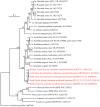Molecular detection of Candidatus Scalindua pacifica and environmental responses of sediment anammox bacterial community in the Bohai Sea, China
- PMID: 23577216
- PMCID: PMC3620062
- DOI: 10.1371/journal.pone.0061330
Molecular detection of Candidatus Scalindua pacifica and environmental responses of sediment anammox bacterial community in the Bohai Sea, China
Abstract
The Bohai Sea is a large semi-enclosed shallow water basin, which receives extensive river discharges of various terrestrial and anthropogenic materials such as sediments, nutrients and contaminants. How these terrigenous inputs may influence the diversity, community structure, biogeographical distribution, abundance and ecophysiology of the sediment anaerobic ammonium oxidation (anammox) bacteria was unknown. To answer this question, an investigation employing both 16S rRNA and hzo gene biomarkers was carried out. Ca. Scalindua bacteria were predominant in the surface sediments of the Bohai Sea, while non-Scalindua anammox bacteria were also detected in the Yellow River estuary and inner part of Liaodong Bay that received strong riverine and anthropogenic impacts. A novel 16S rRNA gene sequence clade was identified, putatively representing an anammox bacterial new candidate species tentatively named "Ca. Scalindua pacifica". Several groups of environmental factors, usually with distinct physicochemical or biogeochemical natures, including general marine and estuarine physicochemical properties, availability of anammox substrates (inorganic N compounds), alternative reductants and oxidants, environmental variations caused by river discharges and associated contaminants such as heavy metals, were identified to likely play important roles in influencing the ecology and biogeochemical functioning of the sediment anammox bacteria. In addition to inorganic N compounds that might play a key role in shaping the anammox microbiota, organic carbon, organic nitrogen, sulfate, sulfide and metals all showed the potentials to participate in the anammox process, releasing the strict dependence of the anammox bacteria upon the direct availability of inorganic N nutrients that might be limiting in certain areas of the Bohai Sea. The importance of inorganic N nutrients and certain other environmental factors to the sediment anammox microbiota suggests that these bacteria were active for the in situ N transforming process and maintained a versatile life style well adapted to the varying environmental conditions of the studied coastal ocean.
Conflict of interest statement
Figures







Similar articles
-
Environmental factors shape sediment anammox bacterial communities in hypernutrified Jiaozhou Bay, China.Appl Environ Microbiol. 2010 Nov;76(21):7036-47. doi: 10.1128/AEM.01264-10. Epub 2010 Sep 10. Appl Environ Microbiol. 2010. PMID: 20833786 Free PMC article.
-
Seasonal dynamics of anammox bacteria in estuarial sediment of the Mai Po Nature Reserve revealed by analyzing the 16S rRNA and hydrazine oxidoreductase (hzo) genes.Microbes Environ. 2011;26(1):15-22. doi: 10.1264/jsme2.me10131. Microbes Environ. 2011. PMID: 21487198
-
Deep-sea methane seep sediments in the Okhotsk Sea sustain diverse and abundant anammox bacteria.FEMS Microbiol Ecol. 2014 Feb;87(2):503-16. doi: 10.1111/1574-6941.12241. Epub 2013 Nov 18. FEMS Microbiol Ecol. 2014. PMID: 24164560
-
Molecular and stable isotope methods to detect and measure anaerobic ammonium oxidation (anammox) in aquatic ecosystems.Methods Enzymol. 2011;496:63-89. doi: 10.1016/B978-0-12-386489-5.00003-8. Methods Enzymol. 2011. PMID: 21514460 Review.
-
Ecology and physiology of anaerobic ammonium oxidizing bacteria.Environ Microbiol. 2016 Sep;18(9):2784-96. doi: 10.1111/1462-2920.13134. Epub 2016 Jan 18. Environ Microbiol. 2016. PMID: 26616750 Review.
Cited by
-
Bacterial taxonomic and functional profiles from Bohai Sea to northern Yellow Sea.Front Microbiol. 2023 Feb 23;14:1139950. doi: 10.3389/fmicb.2023.1139950. eCollection 2023. Front Microbiol. 2023. PMID: 36910186 Free PMC article.
-
Community Composition and Abundance of Anammox Bacteria in Cattail Rhizosphere Sediments at Three Phenological Stages.Curr Microbiol. 2017 Nov;74(11):1349-1357. doi: 10.1007/s00284-017-1324-9. Epub 2017 Aug 5. Curr Microbiol. 2017. PMID: 28780699
-
Microsatellite markers reveal genetic diversity and population structure of Portunus trituberculatus in the Bohai Sea, China.Sci Rep. 2023 May 29;13(1):8668. doi: 10.1038/s41598-023-35902-1. Sci Rep. 2023. PMID: 37248314 Free PMC article.
-
Effects of Salts on the Activity and Growth of "Candidatus Scalindua sp.", a Marine Anammox Bacterium.Microbes Environ. 2018 Sep 29;33(3):336-339. doi: 10.1264/jsme2.ME18068. Epub 2018 Aug 24. Microbes Environ. 2018. PMID: 30146541 Free PMC article.
-
Diversity and spatial distribution of hydrazine oxidoreductase (hzo) gene in the oxygen minimum zone off Costa Rica.PLoS One. 2013 Oct 31;8(10):e78275. doi: 10.1371/journal.pone.0078275. eCollection 2013. PLoS One. 2013. PMID: 24205176 Free PMC article.
References
-
- Mulder A, van de Graaf AA, Robertson LA, Kuenen JG (1995) Anaerobic ammonium oxidation discovered in a denitrifying fluidized bed reactor. FEMS Microbiol Ecol 16: 177–183.
-
- Strous M, Fuerst JA, Kramer EH, Logemann S, Muyzer G, et al. (1999) Missing lithotroph identified as new planctomycete. Nature 400: 446–449. - PubMed
-
- Kuypers MMM, Sliekers AO, Lavik G, Schmid M, Jøgensen BB, et al. (2003) Anaerobic ammonium oxidation by anammox bacteria in the Black Sea. Nature 422: 608–611. - PubMed
Publication types
MeSH terms
Substances
LinkOut - more resources
Full Text Sources
Other Literature Sources
Molecular Biology Databases

